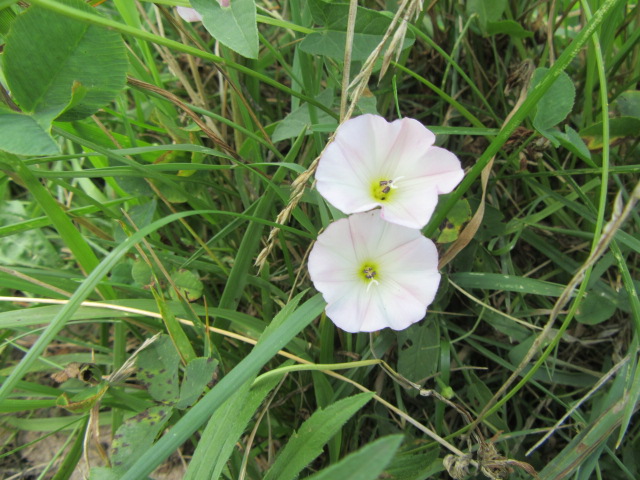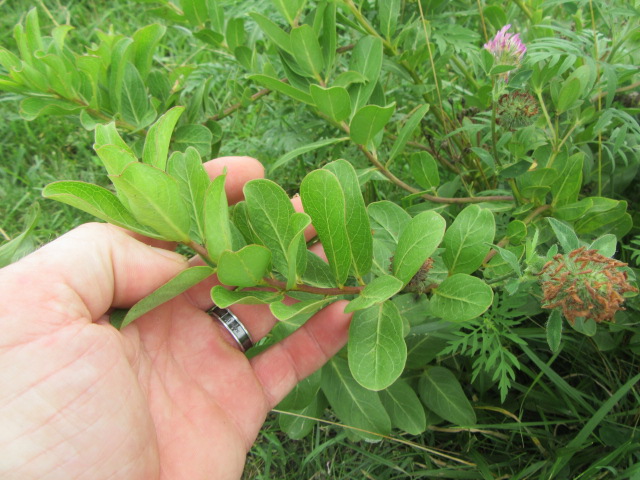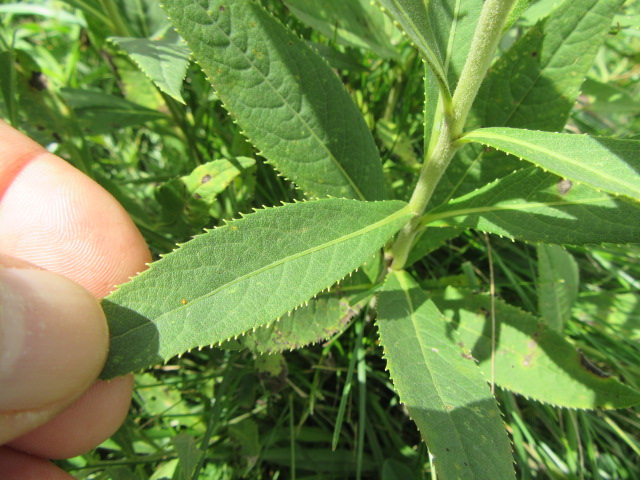
Convolvulus arvensis (Field Bindweed) on 6-24-19.
Hello everyone! I hope this post finds you all well. I guess the title of this post could get some attention for many reasons. Many of us are on a quest for the truth about something because, after all, the truth will set you free. We wonder about the truth of who we are when traditional religious teaching leaves us asking questions we are told have no answers. Some of us accept there are no answers and we go about life la-de-da. Well, I am not one of those people. While I may live in my own little la la land sometimes, it is far from a life of not knowing who I am, where I came from or where I am going. I have concluded it doesn’t really matter where or how we originated. What matters is who we are now and how we embrace life day by day. Growing spiritually, being thankful, and remaining positive are a few keys to living a happy and abundant life. We continue learning and making new discoveries which makes life truly amazing.
I have thoroughly enjoyed working outside this summer. The past several months spraying and digging thistles on Kevin’s farm have allowed me to watch many wildflower species grow and flower. I have identified many species not growing on the 38 (or so) acres where I live which has been pretty exciting. There are many plants I haven’t identified fully because I am waiting for flowers which can get a bit entertaining. Partly because sometimes I can’t find a plant I was watching and partly because the cows eat them before they flower. So many species in different genera look alike while they are growing then they change when they are about to bud and flower. Some plants of the same species look different growing in different areas of the pasture.
Taking a lot of photos of many different plants can be somewhat confusing if you let it be. Going from one plant to the next then finding better specimins later. Maybe a feature you didn’t shoot before to help clarify a species… I usually photograph a finger (or fingers) between plants. I have learned from experience to take as many photos as possible when you have a chance. You may think there will be other plants of the species somewhere else but maybe not. Then later, when you didn’t find any others, you may not be able to find the plant you photographed earlier. Been there, done that more than once.

Convolvulus arvensis (Field Bindweed) on 6-24-19.
One of the many plants I haven’t encountered before is the Convolvulus arvensis commonly known as the Field Bindweed. There were several flowering in the front area of Kevin’s pasture all white flowers with five pale pink stripes. I saw one on the west side with all white flowers and information on Midwest Weeds and Wildflowers says they are commonly all white or mostly pink. There are five pink bracts on the underside of the flowers which may be why the flowers appeared to have pink stripes. The bracts distinguish it from the Hedge Bindweed (Calystegia sepium). Their roots can grow from 8 to 30 feet deep with stems up to 9 feet long. Their roots can send up many shoots and a group of these can spread up to 20′ per year. They produce LOTS of seeds which are viable for up to 30 years!

Asclepias sp. in question on July 17.
The biggest issue I have been dealing with is the cows eating the plants I have been watching. I am certainly not complaining about the cows or anything. It is just the way it is and part of the cycle of life and nature. The milkweeds are a good example. The cluster of milkweed I posted about before that I couldn’t ID was likely because it had been snacked on at an earlier age. I took the above photo on July 17, which you can tell from the caption. 🙂

Asclepias sp. in question on July 17.
This probably caused the leaves to be smaller and is perhaps what caused the stems to a different color than they would have been had if they had been allowed to grow to maturity naturally. While the growth habit, even though nipped earlier, sort of remained the same. So, the Asclepias viridis (Green Milkweed) would still remain a bit of a sprawler. Even though several Asclepias syriaca (Common Milkweed) stems were eaten earlier, the growth that remained would still grow upright. Both the Common Milkweed and Green Milkweed have similar leaf veins but their growth habit, leaf shape and other characteristics remain true for the species.

On Monday, July 22, I went to Kevin’s farm to locate the Milkweed I previously questioned to get more photos. I wanted more in-depth photos of its leaves and stems on the upper and lower parts of the plant. I didn’t work on Monday so I wasn’t taking time away from my duties. Hmmm… I went to where I thought it was and it was not there. I thought maybe I wasn’t in the right spot so I walked around a bit and still couldn’t find it. So, I went back to where I originally thought it was and found a clump that was probably it. I remembered the clover and other weeds growing with the clump which was the determining factor but the whole spot had been eaten. What remained left me somewhat confused. What remained looked like Asclepias viridis (Green Milkweed). The upper part of the stems that left me questioning what species it was earlier was now missing. At least I am fairly certain this is the same cluster… Hmmm… With the cows grazing and eating all the time, the surroundings change. Plants and parts of plants they like get eaten while weeds they don’t care for continue to grow.

Asclepias sullivantii on 7-22-19.
There are a few milkweeds that look similar but have distinguishing features that separate them from the rest. The Asclepias sullivantii (Prairie Milkweed) grow more upright with up facing leaves. The veins on the leaves are also more refined than the Common Milkweed but the midrib is pretty similar. When there are no flowers it can be somewhat difficult so you have to look for other features. Am I 100% certain? Not going to tell you…
There is a fairly large colony of Asclepias sullivantii in one area but the plants are spread out quite a distance from each other. They are supposed to flower in June and July but none of the plants had flowers during the time I have been there. There are no seed pods…

Arctium minus (Burdock) on 7-22-19.
Then there are the plants that completely change in appearance as they mature. The Arctium minus, commonly known as Burdock, is one of these species. The HUGE lower leaves that look like rhubarb are all but completely gone and have been replaced by smaller leaves and flowers (or buds).

Ruellia humilis (Wild Petunia) on 7-22-19.
Rarely have I seen Ruellia humilis, the Wild Petunia (etc.) with this many leaves. Without the flowers, it may be a little difficult to identify because we look at their flowers first. If I saw this plant without flowers, not having seen one this large and with so many leaves, I may not have even recognized it. The only plants I have been around are those that have been in the pastures and the ditch where they are constantly eaten or mowed. The one in the above photo somehow escaped being eaten. When I mowed on Saturday I also noticed a large specimen in an area of the ditch here that hadn’t been mowed. The Wild Petunia is a true survivor.
We depend a lot on flowers for proper identification but sometimes that isn’t enough when there are many species in a genus that all have similar flowers. We have to look to their leaves and stems and sometimes their calyces on the underside of the flower may be the only difference.
Sometimes we get a little surprise and have to rethink what we think we know. Notice I am saying “we” (trying to avoid “I”).

Unidentified species on 7-22-19.
Several clumps I have been watching have done this… It is in an area where there are several Vernonia baldwinii (Baldwin’s Ironweed) that are now beginning to flower. This plant is definitely not an Ironweed. The teeth on the upper leaves look like little nubs…

Hmmm…
The upper leaves are growing upright…

Double HMMM…
The teeth on the lower leaves look similar to many species, including Ironweed… Well, some of them… As these plants grew the teeth on their leaves changed somewhat.
Over the years I have taken a lot of wildflower photos on the farm but not always in every stage. So, it could be I will recognize it once it flowers.

Vernonia sp. (Ironweed) on 7-24-19.
As I mentioned, the Vernonia baldwinii are now beginning to flower. Actually, some had started earlier in another area and I included them in an earlier post. This plant is Baldwin’s Ironweed which most people just call Ironweed. At my place, an Ironweed is an Ironweed but I noticed something a little weird.

Dark stems on this cluster of Ironweed on 7-24-19.
This particular cluster of Ironweed has very dark stems. Some colonies stems are darker than others but have the same general characteristics otherwise. Stems partially dark but not necessarily the entire stem.
Have you ever thought something was right then started feeling maybe not?

Again with the Hmmm…
Notice the stems, or whatever you call them, on the entire inflorescence are a maroonish color… Well, I think it looks pretty neat!

GEEZ!
And then there is this one… No dark stems…

DOUBLE GEEZ!
Its inflorescence looks like this! No maroonish color at all!

TRIPLE GEEZ!
WHAT IS THIS? Its leaves look like the plant in question from before with the little nubs! Hmmm…

Ummm…
Here is a blooming inflorescence of the same, umm, Ironweed in a different spot.

…
Here is the whole group of Ironweed without dark stems. What you don’t notice in the photo is that these plants have a reddish glow which is quite fascinating in person.
Missouriplants.com gives descriptions of four species of Ironweed. The Missouri State University website, Midwest Weeds and Wildflowers, has five. Looking at their descriptions of Vernonia baldwinii AND photos I took of plants here last year… Ummm… They all are plants with green stems and not dark. Vernonia gigantea (or Vernonia gigantea var. gigantea), the Tall Ironweed, has dark stems. Information says Vernonia baldwinii is “variable” and sometimes difficult to ID. Species in the genus cross to form hybrids as well. The different species can be identified by looking at the bracts surrounding the flower head. The phyllaries are somewhat different, but GEEZ!!!
So, I sent Pamela of Missouri State University some photos to get her input. The photos in the folder are not all labeled because they are not all ID’d. Actually, the photos in the last three folders are not all labeled. Each day of photos is in separate folders… Ummm… 606 folders so far since 2009.
Well, I think I will conclude this post and start on part 2. There may even be a part 3 and 4. I kind of like the name of this post. The Quest For Truth…
Until next time, be safe and stay positive. Be thankful and get out and enjoy the fresh air.
It truly is a mystery… I look forward to finding out what the expert thinks!
LikeLiked by 1 person
Hello Dr. Jan! I think it is either Vernonia gigantea or a “variable” Vernonia baldwinii. I think those are the only two choices. But, you never know. Pamela will probably get back with me on Monday. Thanks for the comment!
LikeLiked by 1 person
I’ve got some of that A. sullivantii in the garden. It’s less aggressive than the common milkweed.
LikeLike
Hello Jason! Glad to hear you have some A. sullivantii in your garden and that it is not so agressive. I hope all is well with you. Thanks for the comment!
LikeLike